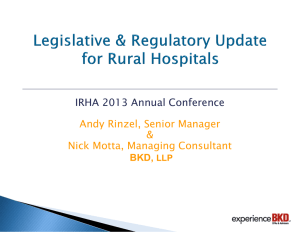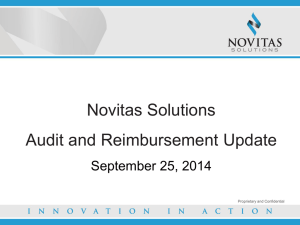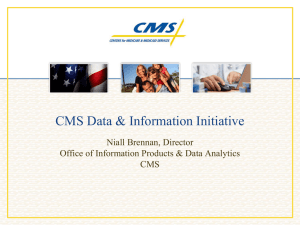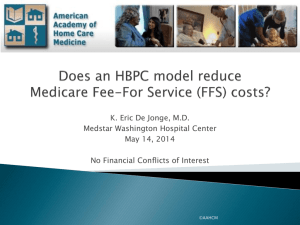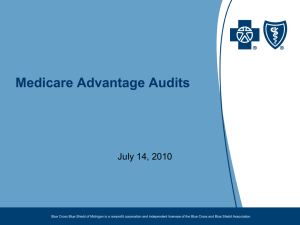FY 2015 onward - Core Finance Team
advertisement
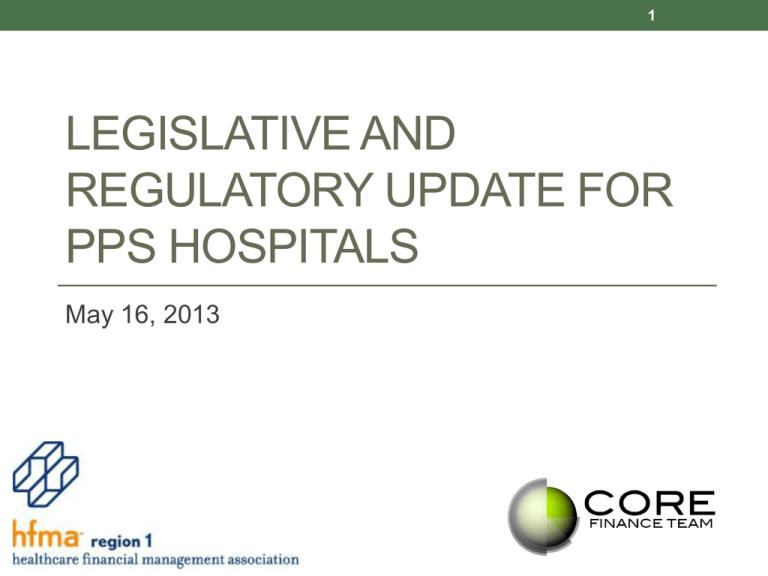
1 LEGISLATIVE AND REGULATORY UPDATE FOR PPS HOSPITALS May 16, 2013 2 Agenda • FFY 2014 IPPS Proposed Rule • Overall Financial Impact (Mike) • Coding & Documentation Adjustments (Brad) • Readmission Measures (Mike) • Wage Index (Brad) • Hospital Acquired Conditions Payment Reductions (Mike) • Uncompensated Care / DSH (Brad) • Graduate Medical Education (Mike) • Short Inpatient Stays / Observation (Brad) • Other Legislative and Regulatory Updates (Mike) 3 OVERALL FINANCIAL IMPACT 4 Impact of Proposed Changes on Operating Costs Operating Cost Changes Net rate adjustment Readmissions Reduction Program DRG weight & wage index adjustments, net of budget neutrality Application of Frontier wage index Medicare DSH changes Expiration of MDH status All Hospitals 0.8% -0.2% 0.1% 0.1% -0.9% -0.1% 5 Operating and Capital % Changes All Hospitals Urban Hospitals Rural Hospitals New England - Urban New England - Rural Operating Cost Changes Capital Changes -0.1% 0.1% -1.9% 0.2% -2.9% 1.1% 1.2% 0.6% 2.3% 1.7% 6 Rebasing and Revising the IPPS Market Basket • Rebasing from FY 2006 to a more current FY 2010 will have little impact on estimated Hospital Operating Index Percent Change. • Labor portion for markets with a wage index >1.00 would change from the current 68.8% to 69.6%, slightly increasing the impact of the wage index for hospitals with a wage index above 1.00. • Labor portion for markets with a wage index of =<1.00 will remain at 62%. 7 Methodology for Calculation of the Proposed Relative Weights for MS-DRGs • CMS proposing to calculate the relative weights based on 19 Cost to Charge Ratios (CCRs), instead of the current 15 CCRs. • CMS will use the FFY 2011 Medicare Cost reports filed on form 2552-10. • CMS will be adding new CCRs for 1) implantable devices, 2) MRIs, 3) CT scans, and 4) cardiac catheterization. 8 Proposed National Standardized Rates ASSUMES FULL UPDATE (ALT - 2% REDUCTION) FFY 2014 FFY 2013 % Change Operating Standardized Amounts Wage Index > 1.0 Labor-related Nonlabor-related 3,741.72 1,634.32 3,679.95 1,668.81 1.7% -2.1% Wage Index <=1.0 Labor-related Nonlabor-related 3,333.14 2,042.90 3,316.23 2,032.53 0.5% 0.5% 432.03 425.49 1.5% 40,622.06 40,397.96 0.6% 69.6% 62.0% 68.8% 62.0% Capital Standard Federal Payment Rate LTCH Standard Federal Rate Labor Percentage Wage Index > 1.0 Wage Index <=1.0 9 CODING & DOCUMENTATION ADJUSTMENTS 10 MS-DRG Documentation and Coding Adjustment • Section 631 of the American Taxpayer Relief Act of 2012 requires CMS to recoup $11B in FY 2014 - FY 2017. • CMS has estimated that this will take an adjustment of -9.3%. • Proposing to take -0.8% if FFY 2014 and leave -8.5% payment adjustment for the following 3 years. 11 MS-DRG Documentation and Coding Adjustment • FFY 2014 • FFY 2015 Prior year’s decrease and additional (0.8)% • FFY 2016 Prior year’s decrease and additional (0.8)% • FFY 2017 Prior year’s decrease and additional (0.8)% (0.8)% (1.6)% (2.4)% (3.2)% • Question – Does that mean that in FFY 2018 the 3.2% adjustment for FFY 2017 will be reversed, since in theory the $11B will have been recouped? 12 READMISSION MEASURES 13 Readmission Adjustment Factor Floor Adjustment Factor for FY 2014 • The Ratio equals to 1 minus (the aggregate payments for excess readmissions / the aggregate payments for all discharges). • The hospital will receive an adjustment factor that is the greater of the Ratio or a floor adjustment factor of 0.98 in FFY 2014. • In other words, for FY 2014, a hospital subject to the Hospital Readmissions Reduction Program would have an adjustment factor that is between 1.0 and 0.98. • In FFY 2015 the floor adjustment factor increase to .97 (or a potential for 3% reduction to payments). 14 Readmission Measures MedPAR Data to be Used • FY 2014 CMS is proposing to determine aggregate payments for excess readmissions and aggregate payments for all discharges using data from MedPAR claims with discharge dates that are on or after July 1, 2009, and no later than June 30, 2012. • Medicare Advantage (MA) admission will continue to be excluded. • FY 2013,CMS excluded admissions for MA patients based on whether the claim was identified as a MA claim in the MedPAR file or whether the FFS payment amount on the claim was for an IME payment only. • FY 2014, CMS would exclude admissions for patients enrolled in MA as identified in the Enrollment Database. 15 Refinement of the Readmission Measures New Measures for FFY 2015 • CMS is proposing to expand the applicable conditions and procedures to include: • Patients admitted for an acute exacerbation of COPD; and • Patients admitted for elective total hip arthroplasty (THA) and total knee arthroplasty (TKA). • Bring to total 5 measures with the existing acute myocardial infarction (AMI), heart failure (HF), and pneumonia (PN) readmission measures. 16 Refinement of the Readmission Measures CMS Planned Readmission Algorithm Version 2.1 • This algorithm is a set of criteria for classifying readmissions as “planned”. The algorithm identifies typical planned admissions that may occur within 30 days of discharge from the hospital. • CMS Planned Readmission Algorithm based on 3 principles: • A few specific, limited types of care are always considered planned (obstetrical delivery, transplant surgery, maintenance chemotherapy, rehabilitation); • Otherwise, a planned readmission is defined as a non-acute readmission for a scheduled procedure; and • Admissions for acute illness or for complications of care are never planned. 17 Refinement of the Readmission Measures • CMS is proposing that if the first readmission is planned, it will not count as a readmission, nor will any subsequent unplanned readmission within 30 days. • In other words, unplanned readmissions that occur after a planned readmission and fall within the 30-day post discharge timeframe would no longer be counted as outcomes for the first admission. • CMS estimates this will have a minimal impact. 18 Discharge/Transfer to Designated Disaster Alternative Care Site • CMS is proposing to add new patient discharge status code 69 (Discharged/transferred to a designated disaster alternative care site). • Will only be used with three MS-DRGs : • 280 (Acute Myocardial Infarction Discharged Alive with MCC), • 281 (Acute Myocardial Infarction Discharged Alive with CC), and • 282 (Acute Myocardial Infarction Discharged Alive without CC/MCC). 19 Discharges/Transfers With a Planned Acute Care Hospital Inpatient Readmission # Description # Description # Description 81 Home/Self care 86 HHA 91 LTCH 82 Short Term Hospital 87 Court / Law Enforcement 92 Nursing Facility certified by MCaid not MCare 83 SNF 88 Federal Health Care Facility 93 Psych Distinct Part Unit 84 Custodial / Supportive care 89 Swing Bed 94 CAH 85 Cancer / Children's Hospital 90 IRF / Rehab Distinct Part Unit 95 Other Health Care Institution • Will only be used with three AMI MS-DRGs 280,281, 282. 20 WAGE INDEX 21 Core-Based Statistical Areas for the Hospital Wage Index • On 2/28/2013, OMB issued OMB Bulletin No. 13-01, which established revised delineations for Metropolitan Statistical Areas, Micropolitan Statistical Areas, and Combined Statistical Areas, • There are new CBSAs, urban counties that become rural, rural counties that become urban, and existing CBSAs that have been split apart. • In addition, the effect of the new designations on various hospital reclassifications, the outmigration adjustment, and treatment of Lugar hospitals located in certain rural counties. 22 Core-Based Statistical Areas for the Hospital Wage Index • CMS believes the data is not available in time to be incorporated into this year’s rulemaking cycle. • To allow for sufficient time to assess the new changes and their ramifications, CMS intends on to proposing changes to the wage index based on the newest CBSA changes in the FY 2015 proposed rule. 23 OMB BULLETIN NO. 13-01 Expected FFY 2015 CBSA Assignments • Released February 28, 2013. • Approximately 170 hospitals assigned to different market. • Rural floor in Massachusetts and Connecticut could be impacted if implemented. Provider Number 070021 220010 220029 220033 220035 220080 220174 220016 Name WINDHAM COMM MEM HOSP & HATCH HOSP LAWRENCE GENERAL HOSPITAL ANNA JAQUES HOSPITAL BEVERLY HOSPITAL CORPORATION NORTH SHORE MEDICAL CENTER HOLY FAMILY HOSPITAL, A CARITAS FAMILY HOSPITAL MERRIMACK VALLEY HOSPITAL BAYSTATE FRANKLIN MEDICAL CENTER County WINDHAM, CT ESSEX, MA ESSEX, MA ESSEX, MA ESSEX, MA ESSEX, MA ESSEX, MA FRANKLIN, MA CBSA Connecticut Peabody, MA Peabody, MA Peabody, MA Peabody, MA Peabody, MA Peabody, MA Springfield, MA Post Reclass CBSA Connecticut Boston-Quincy, MA Boston-Quincy, MA Boston-Quincy, MA Boston-Quincy, MA Boston-Quincy, MA Boston-Quincy, MA Springfield, MA FFY 2015 Projected new CBSA before RECLASS Worcester Cambridge-Newton-Framingham Cambridge-Newton-Framingham Cambridge-Newton-Framingham Cambridge-Newton-Framingham Cambridge-Newton-Framingham Cambridge-Newton-Framingham Massachusetts 24 Imputed Rural Floor • CMS is proposing to extend the imputed floor policy (both the original methodology (NJ – 35 hospitals) and the alternative methodology (RI - 4 hospitals) for one additional year, through September 30, 2014, while they continue to explore potential wage index reforms. 25 Change in Payments from Rural Floor with Budget Neutrality State Massachusetts California Connecticut New Jersey* Nevada New Hampshire Rhode Island* Vermont Maine Indiana Ohio Pennsylvania Illinois Florida Texas New York * Imputed rural floor # of Provider # of Provider Paid Rural Floor % of Provider Paid Rural Floor % Change in Payments Change (in Millions) 61 308 32 64 24 13 11 6 20 89 137 157 127 168 322 166 60 178 27 35 19 9 4 0 0 4 3 6 5 5 3 2 98.4% 57.8% 84.4% 54.7% 79.2% 69.2% 36.4% 0.0% 0.0% 4.5% 2.2% 3.8% 3.9% 3.0% 0.9% 1.2% 5.6% 0.9% 4.9% 0.4% 1.6% 0.8% 0.5% -0.4% -0.5% -0.5% -0.4% -0.5% -0.6% -0.4% -0.5% -0.6% $169.10 $86.40 $75.00 $14.80 $10.90 $3.60 $1.70 ($0.80) ($2.40) ($12.90) ($17.70) ($21.80) ($26.80) ($29.60) ($31.90) ($46.50) 26 FFY 2014 Proposed Rule Wage Index 27 FFY 2014 Proposed Rule Wage Index 28 Occupational Mix Survey • The next Occupational Mix Survey will use the provider’s data from Calendar year 2013 • The results will be used to adjust payments in FFY 2016, 2017 and 2018. • CMS will be using the same rules and definitions that are currently in use as well as the same survey form. 29 HOSPITAL ACQUIRED CONDITIONS PAYMENT REDUCTION 30 Hospital Acquired Conditions Reduction Program • Section 3008 of the ACA requires a 1% reduction in payment to hospitals in the top (worst performing) quartile in FFY 2015. • Use the 24-month period from July 1, 2011 through June 30, 2013 as the applicable time period for the AHRQ measures (Domain 1) and Calendar 2012 and 2013 for the CDC measures (Domain 2) to be applied to FFY 2015 payment. • Domain 1 and Domain 2 would be equally weighted if the date is available to create a Total HAC Score. • Hospitals will have a period of 30 days to review and submit corrections for their Total HAC Scores for the HAC Reduction Program. 31 Hospital Acquired Conditions Reduction Program Domain 1: AHRQ Patient Safety Indicators Proposed Approach: Alternative Approach: 6 individual measures One composite of 8 component (FY 2015 onward) indicators (FY 2015 onward) PSI-3 (Pressure ulcer rate) PSI-5 (Foreign object left in body) PSI-6 (Iatrogenic pneumothorax rate) PSI-10 (Postoperative physiologic and metabolic derangement rate) PSI-12 (Postoperative PE/DVT rate) PSI-15 (Accidental puncture & laceration rate) PSI-90 PSI-3 (Pressure ulcer rate) PSI-6 (Iatrogenic pneumathorax rate) PSI-7 (Central venous catheter related blood stream infections rate) PSI-8 (Postoperative hip fracture rate) PSI-12 (Postoperative PE/DVT rate) PSI-13 (Postoperative sepsis rate) PSI-14 (Wound dehiscence rate) PSI-15 (Accidental puncture & laceration rate) 32 Hospital Acquired Conditions Reduction Program Domain 2: CDC HAI Measures Apply to Proposed Approach and Alternative Approach (Multiple FYs) • Central Line-associated Blood Stream Infection (CLABSI) (FY 2015 onward) • Catheter-associated Urinary Tract Infection (CAUTI) (FY 2015 onward) • Surgical Site Infection (SSI): ◦ SSI Following Colon Surgery (FY 2016 onward) ◦ SSI Following Abdominal Hysterectomy (FY 2016 onward) • Methicillin-resistant Staphylococcus aureus (MRSA) Bacteremia (FY 2017 onward) • Clostridium difficile (FY 2017 onward) 33 UNCOMPENSATED CARE / DSH PAYMENTS 34 New Uncompensated Care Payment • Section 3313 of the ACA reduces Federal DSH payments by 75% and replaces it with a payment for Uncompensated Care. • Three factors multiplied in the calculation: • Factor 1 is a pool of the 75% of empirical DSH payment for all DSH hospitals nationally, • Factor 2 is 1- the % reduction in the uninsured plus a statutory addition, and • Factor 3 is hospital-specific value of uncompensated care relative to the estimated uncompensated care amount for all DSH hospitals. 35 New Uncompensated Care Payment Factor 3 • Cost reporting worksheet S-10 not used to calculate uncompensated care for FFY 2014 in proposed rule due to concerns over the reliability of the data in the new worksheet. • CMS has selected a method of using Insured low-income patient days (defined as inpatient days of Medicaid patients plus inpatient days of Medicare SSI patients). • Creating a fraction of the DSH provider’s insured low income days / Total insured low income days of all DSH providers. • Secretary has the authority to use estimates of uncompensated care, which is non-reviewable neither administratively nor judicially. 36 New Uncompensated Care Payment • CMS is estimating that Factor 1 will be $9.2535B or about 7% higher than amount calculated from the NPRM FFY2014 IPPS impact file. • CMS is using the March 20, 2010 CBO projection for 2013 (18%) and the February 5, 2013 CBO projection of uninsured for all residents for 2014 (16%) for Factor 2. • By statue CMS must reduce Factor 2 by -0.1% for FFY 2014. • A table of hospital specific Factor 3 is on CMS’ website where they publish SSI% by year. 37 New Uncompensated Care Payment Example Calculation Estimate DSH payments Nationally for all DSH hospitals in FFY 2014 Factor 1 (75% of total) Estimated FY 2013 uninsured rate Estimated FY 2014 uninsured rate Stautory reduction Formula for Factor 2 Factor 2 $12,338.0 in $M $9,253.5 in $M (other 25% was paid as DSH) 18.0% from CBO 16.0% from CBO -0.1% FFY 2015-17 increases to -0.2% (1-((18%-16%)/18%))-0.1 0.888 Providers Mcaid & SSI days Estimated National Mcaid & SSI days Factor 3 10,000 35,880,857 0.0002787 Interim Uncompensated Care Payment $2,289,823 Product of Factors 1, 2 and 3 38 New Uncompensated Care Payment • In the case of hospitals that CMS estimated would receive a Medicare DSH payment for a fiscal year and that received interim DSH payments and uncompensated care payments, but are found to be ineligible for DSH payments at cost report settlement, CMS would recover the overpayment. • CMS is proposing to only calculate the denominator once, at the time of the IPPS final rule. CMS will not recalculate the denominator of Factor 3 at the time when cost reports are settled and final eligibility determinations for uncompensated care and Medicare DSH payments. 39 New Uncompensated Care Payment • Like the rest country, as a whole New England hospitals will see a payment reduction with Rhode Island seeing a small increase. Sum of Proposed Factor 3 State Connecticut 1.1396% Maine 0.3395% Massachusetts 2.2361% New Hampshire 0.1386% Rhode Island 0.3869% Vermont 0.0968% Estimate of Difference from Empirical DSH $ (15,110,000) $ (7,310,000) $ (68,350,000) $ (1,130,000) $ 10,140,000 $ (6,410,000) One thing to keep in mind is that it appears there may be some errors CMS’ determination of which hospital will get DSH for FFY 2014 and since you have to get Federal DSH to qualify for an uncompensated care payment we expect some revisions when the final rule is published. 40 New Uncompensated Care Payment Sole Community Hospitals • Same processes of interim and final payments for SCHs that is proposed for eligible IPPS DSH hospitals. • One key difference, SCHs are paid the higher of the Federal rate or a hospital-specific payment rate, under Section 1886(d)(3) of the Act specifically provides that SCH payments are to be made on a per-discharge basis. • Since the Uncompensated Care payment will not be made on a per-discharge basis the payment would not be accounted for in determining whether an SCH is paid the higher of the Federal rate or the hospital-specific rate. 41 Allina Health Services v. Sebelius • On November 15, 2012 the Federal District Court of DC issued a favorable decision for DSH providers. • The court ruled that CMS could not include Medicare Advantage / HMO days in the calculation of the Medicare fraction (SSI%). • In most case this will increase the Medicare fraction (SSI%). • CMS has appealed the decision and will continue with it practice of including MA. • Provider should file cost reports with this as a protested item and appeal all NPRs within 180 days to protect their rights. 42 Medicare Advantage Days in the Medicare Fractions for DSH • In November 2012 Federal District Court for the District of Columbia in a ruling in the case of Allina Health Services, et al., v. Sebelius held putting MA patient days in the Medicare fraction was not a logical outgrowth of prior regulation. • CMS is appealing the decision. • “However, in an abundance of caution and for the reasons discussed above, in this proposed rule, we are proposing to readopt the policy of counting the days of patients enrolled in MA plans in the Medicare fraction of the DPP.” 43 Metropolitan Hospital v. Sebelius • On November March 27, 2013 the Federal District Appeals Court of Western Michigan issued a unfavorable decision for DSH providers. • The dispute is related to dual-eligible exhausted benefit days. • Dual-eligible patient exhausts his or her coverage for a particular spell of illness, then the subsequent patient days are called “dual-eligible exhausted benefit days” and are generally paid by Medicaid as the payor of last resort. 44 Metropolitan Hospital v. Sebelius • In the FFY 2005 IPPS final rule, CMS issued adopting a policy to include the days associated with dual-eligible beneficiaries in the Medicare fraction on the basis that they are and continue to be “entitled to benefits under [Medicare] part A”. • Majority of the court agreed. 45 GRADUATE MEDICAL EDUCATION 46 Counting of Inpatient Days for Medicare Payment or Eligibility Purposes • Patient days associated with maternity patients who were admitted as inpatients and were receiving ancillary labor and delivery services at the time the inpatient routine census is taken would be included in the Medicare utilization calculation. • This will reduce direct GME payments since direct GME payments are partially based upon a hospital’s Medicare utilization ratio. • The change in the treatment of maternity patient would cause the denominator (hospital’s total inpatient days) to increase at a higher rate than the numerator (hospital’s Medicare inpatient days) 47 Residents That Train at CAHs • Section 5504(a) of the Affordable Care Act on a prospective basis to specifically identify the setting in which time spent by residents training outside of the hospital setting may be counted for both direct GME and IME purposes, a hospital’s ability to count residents not training in the hospital is now limited to only those settings that are “nonproviders.” • Since CAH is defined as a provider in the statute, CMS is proposing that, effective October 1, 2013, a hospital may not claim the time FTE residents are training at a CAH for IME and/or direct GME purposes. 48 Residents That Train at CAHs • A CAH may incur the costs of training the FTE residents for the time that the FTE residents rotate to the CAH, and receive payment based on 101 percent of its Medicare reasonable costs under § 413.70 of the regulations. 49 Per Resident Amount • The proposed rule provides notice of the expiration of the freeze applied to certain Per Resident Amount (PRA). • Hospital-specific PRA that exceeded 140% the locality- adjusted national average PRA is set to expire October 1, 2013, the usual full CPI-U update will take place. • If you’re a provider that has previously had your PRA frozen since you exceeded the 140% criteria, I might hold off on budgeting the increase for 1-2 years (since this might be a ripe target for future reductions). 50 SHORT INPATIENT STAYS / OBSERVATION 51 Clarification on Short Inpatient Stays • Hospital inpatient admissions spanning 2 midnights in the hospital would generally qualify as appropriate for payment under Medicare Part A. • According to CMS’ estimate this change would increase IPPS expenditures by approximately $220 million • CMS will use exceptions and adjustments authority under section 1886(d)(5)(I)(i) of the Act to make a reduction of 0.2 percent to the standardized amount to make this a budget neutral item. 52 Part B Payments to Providers Denied Inpatient Payment • On March 13, 2013, CMS concurrently released an immediately effective administrative ruling - CMS Ruling 1455R and a proposed rule – CMS 1455-P. • Reversing CMS policy prevented hospitals from billing on an outpatient basis when inpatient services denied payment on basis that the services should have been outpatient. • Under the new policy, when an audit determines an inpatient service was not medically necessary, a hospital may be able to rebill Medicare Part B for outpatient services. 53 Part B Payments to Providers Denied Inpatient Payment • Hospitals denied for inpatient services may bill separately on a Part B outpatient claim for any outpatient services provided during the three-day payment window. • A hospital denied payment for an inpatient admission must choose between: • 1) Submitting Part B for reasonable and necessary services, or • 2) Maintaining its request for payment of services on a Part A claim. • Be Careful - Hospitals cannot simultaneously requests for payment under both Parts A and B for the same services. 54 OTHER LEGISLATIVE / REGULATORY UPDATES 55 Low-Volume Hospital Definition and Payment Adjustment for FY 2014 and Subsequent Years • For FY 2014, the low-volume hospital qualifying criteria and payment adjustment methodology revert to that which was in effect prior to the amendments made by the Affordable Care Act and the ATRA. • Under this criteria a hospital must be more than 25 road miles from another hospital and have less than 200 total discharges. 56 Medicare Dependent Hospital • Section 606 of the American Taxpayer Relief Act of 2012 extends the MDH program through only FY 2013, effective FY 2014, the MDH program is set to expire. • Keep your eye out for another potential extension of this deadline. 57 Physician Order for Admission • The physician order must be present in the medical record and be supported by the physician admission and progress notes, in order for the hospital to be paid for hospital inpatient services under Medicare Part A. • The following language is proposed for payment: “(b) The order must be furnished by a qualified and licensed practitioner who has admitting privileges at the hospital as permitted by State law, and who is responsible for the inpatient care of the patient at the hospital. The practitioner may not delegate the decision (order) to another individual who is not responsible for the care of that patient, is not authorized by the State to admit patients, or has not been granted admitting privileges applicable to that patient by the hospital’s medical staff.” 58 Physician Payment Sunshine Act • Final rule issued February 1, 2013 and will be effective August 1, 2013. • Requires drug, biological and medical device manufacturers to disclose annually payments made to physicians and teaching hospitals (Covered Recipients) when related to “covered products”. • It also requires manufacturers and GPO to disclose certain ownership and investment interest of Covered Recipients and their immediate family. • Information will be published to a website available to the general public. 59 OIG Issues Updated Self-Disclosure Protocol • The protocol provides guidance on how to: • Investigate the suspected misconduct, • Quantify any damages, and • Report the conduct to the OIG. • First published in 1998, and update via OIG “Open Letters” in 2006,2008 and 2009. • The OIG reaffirmed its presumption, included in the 2008 Open Letter, against requiring a Corporate Integrity Agreement when resolving disclosed conduct; 60 OIG Issues Updated Self-Disclosure Protocol • Providers are expected to disclose in good faith resolving liability within the Civil Monetary Penalties Law’s (“CMPL”) 6 year statute of limitations; • Recognition of the OIG‘s use of various damage calculation methodologies that are tied to the type of conduct disclosed (including the OIG’s practice of requiring a minimum multiplier of 1.5 times damages); • Setting a $10,000 minimum settlement for disclosures not involving potential Anti Kickback Statue violations (involving AKS - $50,000 minimum settlement);and • Billing-related issues must use a sample of at least 100 and use the mean to estimating damages. 61 Healthcare Price Transparency • CMS released the hospital-specific charges for the more than 3,000 U.S. hospitals that receive Medicare IPPS payments for the top 100 most frequently billed MS-DRGs paid under Medicare. • The average of Medicare payments to the provider for the DRG including the DRG amount, teaching, disproportionate share, capital, and outlier payments for all cases. Also included in Total Payments are co-payment and deductible amounts that the patient is responsible for and payments by third parties for coordination of benefits. 62 Healthcare Price Transparency The Numbers and What They Don’t Tell DRG Summary for Medicare Inpatient Prospective Payment Hospitals, FY2011 Top 100 DRGs Based on Total Discharges Note: Includes discharges from Hospitals located within the 50 United States and District of Columbia Hospitals with fewer than 11 discharges within a DRG have been suppressed for that DRG DRG Definition 470 - MAJOR JOINT REPLACEMENT OR REATTACHMENT OF LOWER EXTREMITY W/O MCC Provider Id Provider Name Provider City 15-0160 INDIANA ORTHOPAEDIC HOSPITAL LLC INDIANAPOLIS Total Discharges 529 15-0024 15-0084 15-0128 15-0169 15-0074 15-0056 WILLIAM N WISHARD MEMORIAL HOSPITAL ST VINCENT HOSPITAL & HEALTH SERVICES COMMUNITY HOSPITAL SOUTH COMMUNITY HOSPITAL NORTH COMMUNITY HOSPITAL EAST INDIANA UNIVERSITY HEALTH INDIANAPOLIS INDIANAPOLIS INDIANAPOLIS INDIANAPOLIS INDIANAPOLIS INDIANAPOLIS 51 275 222 204 117 153 Average Covered Charges $30,053 Average Total Payments $11,532 $39,160 $48,699 $50,200 $50,891 $52,244 $66,477 $19,095 $14,227 $11,682 $12,949 $14,234 $20,906 63 Quality Data Reporting Requirements • Objectives • High impact • Improved quality and efficiency • Align with HITECH • Maximize use of electronic data gathering • Releasing more of the detailed measurement results in addition to composite data. • Various changes made adding and removing quality measures with an aim toward meeting above objectives. 64 Proposed Changes for Hospitals Excluded from IPPS • Applicable to: • IRFs • IPFs • LTCHs • CAH • Children’s hospitals • Certain Cancer hospitals • Except for CAHs, each of these now has their own prospective payment methodology, potentially with a transition period • Transition period is over for IRFs, IPFs, and LTCHs. • The increases for IRFs and IPFs are in separate Federal Registers. 65 Proposed Changes for Hospitals Excluded from IPPS Children’s and Cancer Hospitals • Children’s and certain Cancer hospitals are still on a costbased formula subject to a cap, which is increased annually. • The IPPS market basket is being revised and rebased to a 2010 base year. • The increase for FFY 2014 is 2.5%. Critical Access Hospitals (CAHs) • Adding as a condition for participation, that CAH must provide IP services (and not by outsourcing). 66 Proposed Changes for Hospitals Excluded from IPPS Long-Term Care Hospitals (LTCHs) Market basket increase 2.5% Less: MFP adjustment (0.4%) Less: Productivity adjustment (0.3%) Net increase 1.8% • TEFRA to LTCH PPS transition adjustment of -3.75% established in FFY 2013 was spread over 3 years, increasing annually to arrive at the full adjustment. Second year of transition will occur as planned. • Moratorium on applying the 25% referral requirement from a single hospital will expire 10/1/13. 67 Questions and Answers Thank you! 68 Presenters Brad Bowman, MBA Mike Laine, CPA Mobile: 317-459-9146 brad.bowman@corefinanceteam.com • 24 years experience • Formerly PwC Director leading regulatory services and new service development • National speaker on regulatory changes Mobile: 317-435-0879 mike.laine@corefinanceteam.com • 30 years experience • Started CFT in 2008 • Former E&Y leader of HSAS Finance • Specializing in reimbursement strategies, M&A, and strategic financial planning Core Finance Team Office: 317-876-0670 3901 West 86th Street, Suite 310 Indianapolis, IN 46268 Specializing in Medicare payment optimization, mergers and acquisitions, and strategic financial analysis for hospitals and health systems.

